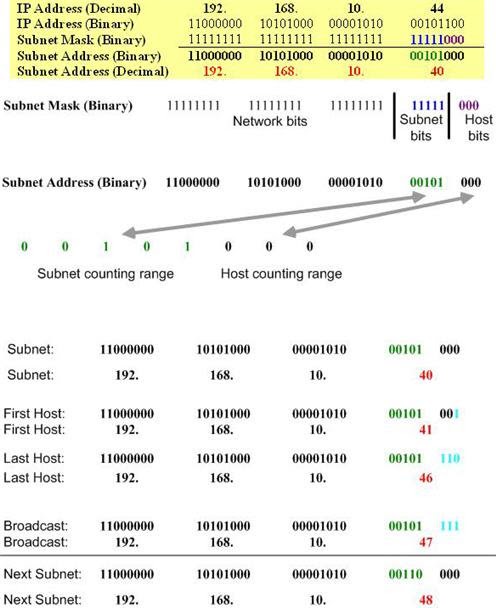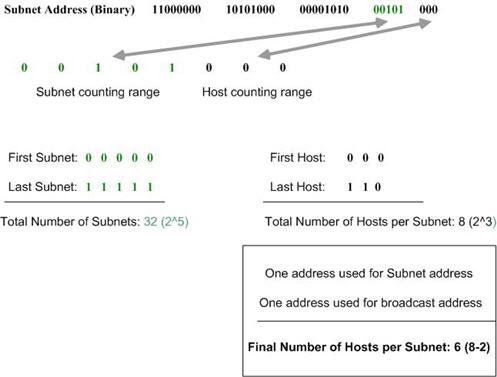Simplify Routing with Subnetting: How to Organize Your Network Into Smaller Subnets
From Subnetting - Calculate Subnet Masks & More | Pluralsight
Simplify Routing with Subnetting: How to Organize Your Network Into Smaller Subnets
By Stelios Antoniou on November 8, 2007
UPDATED October 9, 2019
In my last article, IP Addressing and Routing Part 1: The Invasion of IP Addresses, I presented the architecture of the IP addressing scheme. We went over the IP Network Classes and how to distinguish between them.
If you're new to this field, I would suggest adding both Part 1 and Part 2: IP Routing Process to your reading list, since it provides some additional information that can be useful in getting a firm grasp of the subnetting concept.
In today's article we are going to learn about the concept of IP address subnets and how we can use it to divide our classful network into smaller networks that can operate in separate working zones. We'll also take a look at how we can conserve address space and save resources on process management with the use of subnetting.
I'll use a few examples to clearly present the steps of subnetting and help you master this topic. And although at first this may seem difficult, don't give up! All it takes is some time and practice!
What Is Subnetting?
Subnetting is the process of stealing bits from the HOST part of an IP address in order to divide the larger network into smaller sub-networks called subnets. After subnetting, we end up with NETWORK SUBNET HOST fields. We always reserve an IP address to identify the subnet and another one to identify the broadcast subnet address.
In the following sections you will find out how all this is possible.
Why Use Subnetting?
Here are three reasons why you may want to use subnetting:
Conservation of IP addresses: Imagine having a network of 20 hosts. Using a Class C network will waste a lot of IP addresses (254-20=234). Breaking up large networks into smaller parts would be more efficient and would conserve a great amount of addresses.
Reduced network traffic: The smaller networks that created the smaller broadcast domains are formed, hence less broadcast traffic on network boundaries.
Simplification: Breaking large networks into smaller ones could simplify fault troubleshooting by isolating network problems down to their specific existence.
How to Subnet (or the Concept of Subnetting Explained)
To better understand the concept of subnetting, imagine a network with a total of 256 addresses (a Class C network). One of these addresses is used to identify the network address and another one is used to identify the broadcast address on the network. Therefore, we are left with 254 addresses available for addressing hosts.
If we take all these addresses and divide them equally into 8 different subnets we still keep the total number of original addresses, but we have now split them into 8 subnets with 32 addresses in each. Each new subnet needs to dedicate 2 addresses for the subnet and broadcast address within the subnet.
The result is that we eventually come up with 8 subnets, each one possessing 30 subnet addresses available for hosts. You can see that the total amount of addressable hosts is reduced (240 instead of 254) but better management of addressing space is gained.
Now that we have subnet mask explained, I'll now use a couple of examples to help explain how an IP address subnet mask can be calculated as clearly as possible, but first, here is a quick explanation of “What is a subnet mask?” An IP subnet mask is a number used for defining a range of IP addresses that are available within a network.
How to Subset a Class C Address Using the Binary Method
It can be helpful to know how to be your own subnet mask calculator. Subset a Class C address with the binary method by following these four steps (which will be explained in more detail below):
Convert to binary.
Calculate the subset address.
Find host range.
Calculate the total number of subsets and the hosts per subnet.
We will use a Class C address, which takes 5 bits from the Host field for subnetting and leaves 3 bits for defining hosts as shown in figure 1 below. Having 5 bits available for defining subnets means that we can have up to 32 (2^5) different subnets.
It should be noted that in the past using subnet zero (00000---) and all-ones subnet (11111---) was not allowed. This is not true nowadays. Since Cisco IOS Software Release 12.0 the entire address space including all possible subnets is explicitly allowed.

Let's use IP address 192.168.10.44 with subnet mask 255.255.255.248 or /29.
Step 1: Convert to Binary

Step 2: Calculate the Subnet Address
To calculate the IP Address Subnet you need to perform a bit-wise AND operation (1+1=1, 1+0 or 0+1 =0, 0+0=0) on the host IP address and subnet mask. The result is the subnet address in which the host is situated.

Step 3: Find Host Range
We know already that for subnetting this Class C address we have borrowed 5 bits from the Host field. These 5 bits are used to identify the subnets. The remaining 3 bits are used for defining hosts within a particular subnet.
The Subnet address is identified by all 0 bits in the Host part of the address. The first host within the subnet is identified by all 0s and a 1. The last host is identified by all 1s and a 0. The broadcast address is the all 1s. Now, we move to the next subnet and the process is repeated the same way.
The following diagram clearly illustrates this process:

Step 4: Calculate the Total Number of Subnets and
Hosts Per Subnet
Knowing the number of Subnet and Host bits we can now calculate the total number of possible subnets and the total number of hosts per subnet. We assume in our calculations that all-zeros and all-ones subnets can be used. The following diagram illustrates the calculation steps.

How to Subset a Class C Address
Using the Fast Way
Now let's see how to subnet the same Class C address using a faster method. Let's again use the IP address 192.168.10.44 with subnet mask 255.255.255.248 (/29).
The steps to perform this task are the following:
Total number of subnets: Using the subnet mask 255.255.255.248, number value 248 (11111000) indicates that 5 bits are used to identify the subnet. To find the total number of subnets available simply raise 2 to the power of 5 (2^5) and you will find that the result is 32 subnets. Note that if subnet all-zeros is not used then we are left with 31 subnets and if also all-ones subnet is not used then we finally have 30 subnets.
Hosts per subnet: 3 bits are left to identify the host therefore the total number of hosts per subnet is 2 to the power of 3 minus 2 (1 address for subnet address and another one for the broadcast address)(2^3-2) which equals to 6 hosts per subnet.
Subnets, hosts and broadcast addresses per subnet: To find the valid subnets for this specific subnet mask you have to subtract 248 from the value 256 (256-248=8), which is the first available subnet address. Actually the first available one is the subnet-zero which we explicitly note. Next subnet address is 8+8=16, next one is 16+8=24 and this goes on until we reach value 248.
The following table provides all the subnet cal information. Note that our IP address (192.168.10.44) lies in subnet 192.168.10.40.

Test Your Subnetting Knowledge and Practice, Practice, Practice!
Don't get discouraged if you still don’t quite know how to subnet perfectly. Subnetting is not really that difficult, but it does require a bit of practice.
Go ahead and subnet the network address 192.168.10.0 address using the subnet mask 255.255.255.192 (/26). Find the valid subnets, host ranges, and broadcast addresses per subnet. If you want to double-check your answer, feel free to leave me a comment and I will provide you with the correct solution.
Start with testing your knowledge of subnets and make sure you feel confident about this before you move on to designing your own subnets. But remember, if you're on the Cisco Networking track you will have to deal with subnetting sooner or later, so grab this opportunity and start testing yourself.
If you find you’d benefit from more guidance and hands-on training while learning how to subnet, Pluralsight offers resources that will get you well on your way. Read about some Cool Subnetting Tricks with Variable Length Subnet Mask or sign up for subnetting courses through Pluralsight!

Comments
Post a Comment